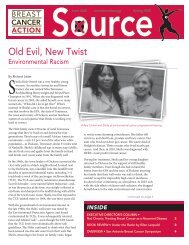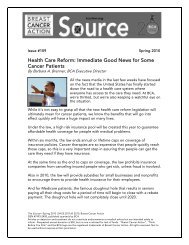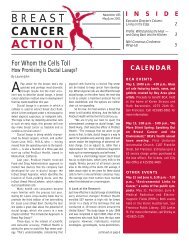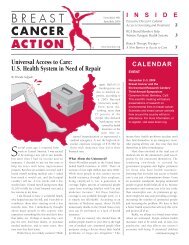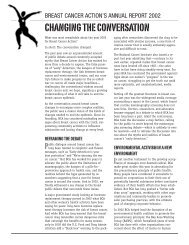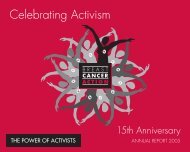Download Newsletter #61 in PDF Format - Return to Home Page ...
Download Newsletter #61 in PDF Format - Return to Home Page ...
Download Newsletter #61 in PDF Format - Return to Home Page ...
You also want an ePaper? Increase the reach of your titles
YUMPU automatically turns print PDFs into web optimized ePapers that Google loves.
2<br />
September/Oc<strong>to</strong>ber 2000<br />
Breast Cancer Action<br />
From the Executive Direc<strong>to</strong>r<br />
Drug Dangers,<br />
Double Standards,<br />
and Echoes from<br />
the Past<br />
By Barbara A. Brenner<br />
As we approach another Oc<strong>to</strong>ber that<br />
will <strong>in</strong>evitably be full of mammography<br />
hype and “look good, feel better”<br />
approaches <strong>to</strong> the breast cancer epidemic, I<br />
f<strong>in</strong>d myself th<strong>in</strong>k<strong>in</strong>g about recent events and<br />
common trends <strong>in</strong> breast cancer. My<br />
thoughts fall <strong>in</strong><strong>to</strong> three categories: bad news<br />
on Hercept<strong>in</strong>; double standards <strong>in</strong> cancer<br />
treatment; and the persistent messages of<br />
Breast Cancer Awareness Month. I th<strong>in</strong>k<br />
these th<strong>in</strong>gs are related and that, taken<br />
<strong>to</strong>gether, they help expla<strong>in</strong> the cont<strong>in</strong>u<strong>in</strong>g<br />
importance of Breast Cancer Action’s work.<br />
Earlier this year, as reported <strong>in</strong> our last<br />
newsletter, there was a great deal of press<br />
attention <strong>to</strong> an advisory issued by Genentech,<br />
the manufacturer of the drug Hercept<strong>in</strong>.<br />
Fifteen of the 25,000 women who have been<br />
treated with the drug had died as a result of<br />
the treatment, and an additional 47 had experienced<br />
serious adverse reactions.<br />
Press calls <strong>to</strong> BCA asked whether we<br />
thought the drug should be taken off the<br />
market. One e-mail I received suggested that<br />
Genentech should be put on trial as a mass<br />
murderer. And I was asked how we could<br />
cont<strong>in</strong>ue <strong>to</strong> support the availability of<br />
Hercept<strong>in</strong> yet oppose the approval of tamoxifen<br />
for use <strong>in</strong> healthy women <strong>to</strong> reduce their<br />
risk of develop<strong>in</strong>g breast cancer.<br />
Keep<strong>in</strong>g <strong>in</strong> m<strong>in</strong>d that Hercept<strong>in</strong> is<br />
approved for use <strong>in</strong> women who have<br />
metastatic disease — cancer that will almost<br />
<strong>in</strong>evitably kill them unless someth<strong>in</strong>g else gets<br />
them first — the question about tak<strong>in</strong>g the<br />
drug off the market is misplaced, and the suggestion<br />
that Genentech is a corporate crim<strong>in</strong>al<br />
for offer<strong>in</strong>g the drug <strong>in</strong> the first place is more<br />
so. We’re not talk<strong>in</strong>g here about women<br />
whose cancer is <strong>in</strong> remission, who might<br />
receive Hercept<strong>in</strong> on an adjuvant basis (that<br />
use is currently <strong>in</strong> trial). We’re talk<strong>in</strong>g about<br />
women whose cancer is active and has already<br />
spread, who are fac<strong>in</strong>g death <strong>in</strong> the relatively<br />
near term, and for some of whom Hercept<strong>in</strong><br />
has the potential <strong>to</strong> prolong life. The world of<br />
risks and benefits looks very different for<br />
those women compared with that for women<br />
whose lives are not <strong>in</strong> immediate danger.<br />
While every death from Hercept<strong>in</strong> is a<br />
tragedy, the fact is that more than 99 percent<br />
of the women treated with the drug have not<br />
had adverse reactions <strong>to</strong> the drug. There is no<br />
such th<strong>in</strong>g as a drug that works with no risks,<br />
and Hercept<strong>in</strong> is the first drug <strong>in</strong> years that<br />
provides the possibility of extend<strong>in</strong>g the lives<br />
of some women with metastatic disease without<br />
the brutal side effects commonly associated<br />
with cy<strong>to</strong><strong>to</strong>xic chemotherapy agents.<br />
The deaths and other harm from the drug<br />
itself require us <strong>to</strong> be diligent about <strong>in</strong>form<strong>in</strong>g<br />
women about the risks and mak<strong>in</strong>g sure that<br />
doc<strong>to</strong>rs moni<strong>to</strong>r patients both for the side<br />
effects and for the conditions that <strong>in</strong>crease the<br />
risk of <strong>in</strong>curr<strong>in</strong>g them. And, as with all new<br />
therapies, ongo<strong>in</strong>g moni<strong>to</strong>r<strong>in</strong>g of their effects<br />
is imperative so that new <strong>in</strong>formation about<br />
benefits and risks is provided <strong>to</strong> patients and<br />
doc<strong>to</strong>rs as soon as it becomes available.<br />
These views are easily reconciled with<br />
BCA’s opposition <strong>to</strong> the market<strong>in</strong>g of tamoxifen<br />
for breast cancer risk reduction <strong>in</strong> healthy<br />
women: Consider the population that is<br />
F rom the trenches of<br />
the war on cancer, the<br />
world looks decidedly<br />
less rosy.<br />
<strong>in</strong>g do<strong>in</strong>g chemotherapy, and we discussed<br />
whether I should opt for CMF (cyclophosphamide,<br />
methotrexate, 5-flurouracil) or a<br />
more aggressive course of AC (adriamyc<strong>in</strong>,<br />
cyclophosphamide), the two chemotherapy<br />
treatments then most commonly given on an<br />
adjuvant basis for breast cancer.<br />
The doc<strong>to</strong>r <strong>to</strong>ld me that the studies that<br />
had been done showed that AC was a more<br />
effective treatment than CMF for node-positive<br />
breast cancer, and that a study compar<strong>in</strong>g the<br />
treatments <strong>in</strong> node-negative patients like me<br />
was under way. He went on <strong>to</strong> say that, while<br />
there were no data yet, his <strong>in</strong>st<strong>in</strong>cts <strong>to</strong>ld him<br />
that there was no reason <strong>to</strong> expect AC <strong>to</strong> be less<br />
effective for node-negative patients than for<br />
node-positive ones, and he would therefore recommend<br />
that treatment. The lesson I <strong>to</strong>ok from<br />
the doc<strong>to</strong>r’s analysis was that, when it comes <strong>to</strong><br />
chemotherapy, what drugs <strong>to</strong> use may be determ<strong>in</strong>ed<br />
by <strong>in</strong>st<strong>in</strong>ct <strong>in</strong>stead of science.<br />
Yet when it comes <strong>to</strong> complementary or<br />
alternative therapies, most oncologists <strong>in</strong>sist<br />
that there is no scientific basis <strong>to</strong> justify their<br />
use. While it may be understandable that<br />
western-tra<strong>in</strong>ed doc<strong>to</strong>rs are more comfortable<br />
rely<strong>in</strong>g on their <strong>in</strong>st<strong>in</strong>cts with respect <strong>to</strong> conventional<br />
treatments than where less conventional<br />
approaches are concerned, this double<br />
standard is not <strong>in</strong> patients’ best <strong>in</strong>terest. Our<br />
doc<strong>to</strong>rs should be as schooled <strong>in</strong> — and as<br />
open <strong>to</strong> — holistic approaches <strong>to</strong> breast cancer<br />
treatment as they are with respect <strong>to</strong> the<br />
aggressive modalities of surgery, chemotherapy,<br />
and radiation.<br />
The need for a broader approach <strong>to</strong><br />
breast cancer treatment, and a more sophisticated<br />
public understand<strong>in</strong>g of risks and benefits<br />
of new (and old) treatments, will be<br />
particularly apparent <strong>to</strong> activists dur<strong>in</strong>g<br />
Breast Cancer Awareness Month, which we at<br />
BCA cont<strong>in</strong>ue <strong>to</strong> call “Breast Cancer Industry<br />
Month.” With the corporate sponsorship of<br />
AstraZeneca (manufacturer of tamoxifen,<br />
owner of cancer treatment centers, and, until<br />
earlier this year, manufacturer of carc<strong>in</strong>ogenic<br />
pesticides), the airwaves and magaz<strong>in</strong>es will<br />
be filled throughout Oc<strong>to</strong>ber with messages<br />
like “Get a mammogram <strong>to</strong> save your life”<br />
and “Breast cancer detected early is almost<br />
100 percent curable.” Hospitals and companies<br />
that want <strong>to</strong> show how much they care<br />
about women will sponsor a breast cancer<br />
day, claim<strong>in</strong>g <strong>to</strong> <strong>in</strong>form the public about the<br />
latest “breakthroughs” <strong>in</strong> the “war aga<strong>in</strong>st<br />
cancer.” Every magaz<strong>in</strong>e with a significant<br />
female readership will focus on personal triumphs<br />
and tragedies, and on the promise of<br />
the latest research.<br />
From the trenches of the war on cancer,<br />
the world looks decidedly less rosy. When the<br />
late Susan Claymon, one of BCA’s founders,<br />
receiv<strong>in</strong>g the drug. When we are talk<strong>in</strong>g about<br />
medical <strong>in</strong>terventions for healthy women, the<br />
standards for mak<strong>in</strong>g drugs available should<br />
be decidedly different from what they should<br />
be when the issue is treatment for women who<br />
have breast cancer. The balance of risks and<br />
benefits looks far different when the woman<br />
receiv<strong>in</strong>g a potentially dangerous drug (tamoxifen<br />
is a known carc<strong>in</strong>ogen) is healthy as<br />
opposed <strong>to</strong> when she is desperately ill. And,<br />
just as an <strong>in</strong>dividual woman will assess the<br />
risk/benefit ratio differently depend<strong>in</strong>g on<br />
whether or not she is currently healthy, the<br />
policy decisions about whether drugs should<br />
be available <strong>to</strong> the public must depend on the<br />
health status of the population <strong>in</strong>tended <strong>to</strong><br />
benefit from the drug’s availability.<br />
But while I don’t see a double standard<br />
<strong>in</strong> argu<strong>in</strong>g that treatments for women with<br />
metastatic disease should be available even<br />
when the risk associated with tak<strong>in</strong>g them are<br />
higher than acceptable for healthy women, I<br />
do see a double standard operat<strong>in</strong>g <strong>in</strong> cancer<br />
treatment. It is best exemplified by a s<strong>to</strong>ry.<br />
When I was evaluat<strong>in</strong>g my options for treatment<br />
after my first diagnosis <strong>in</strong> the fall of<br />
1993, I consulted an very well respected<br />
oncologist <strong>in</strong> San Francisco. I was consider- cont<strong>in</strong>ued on page 12



